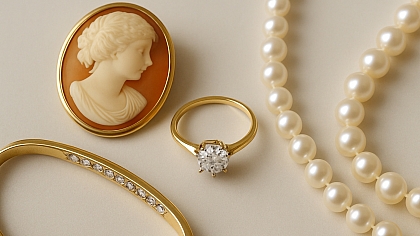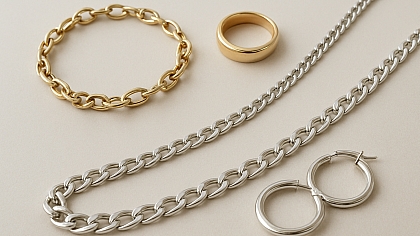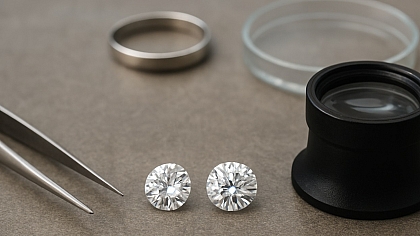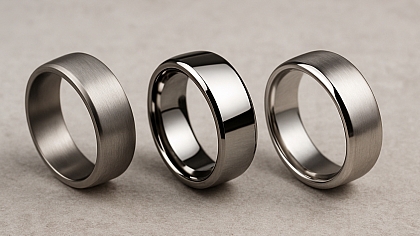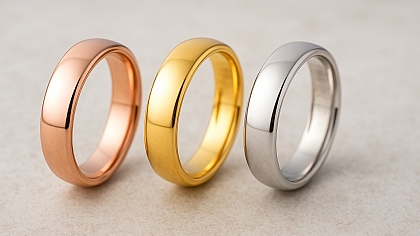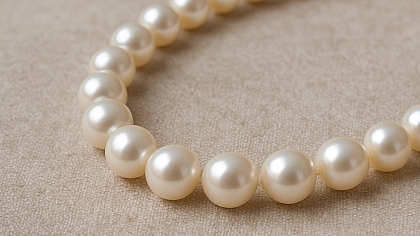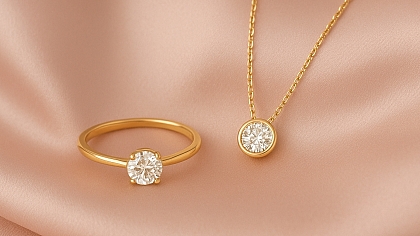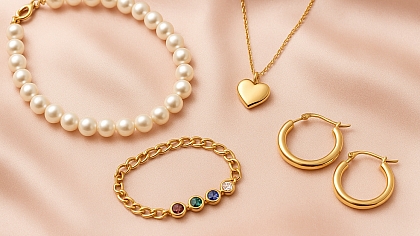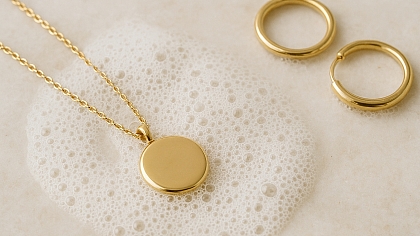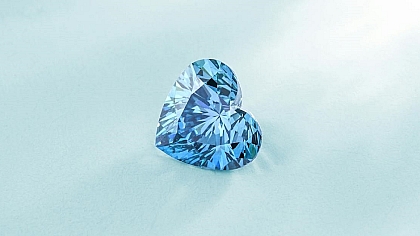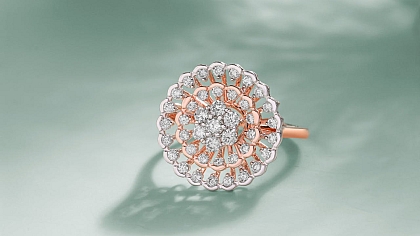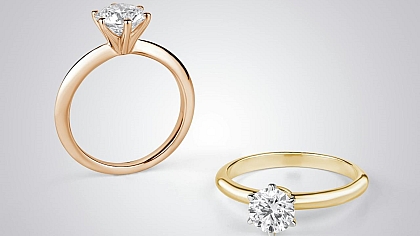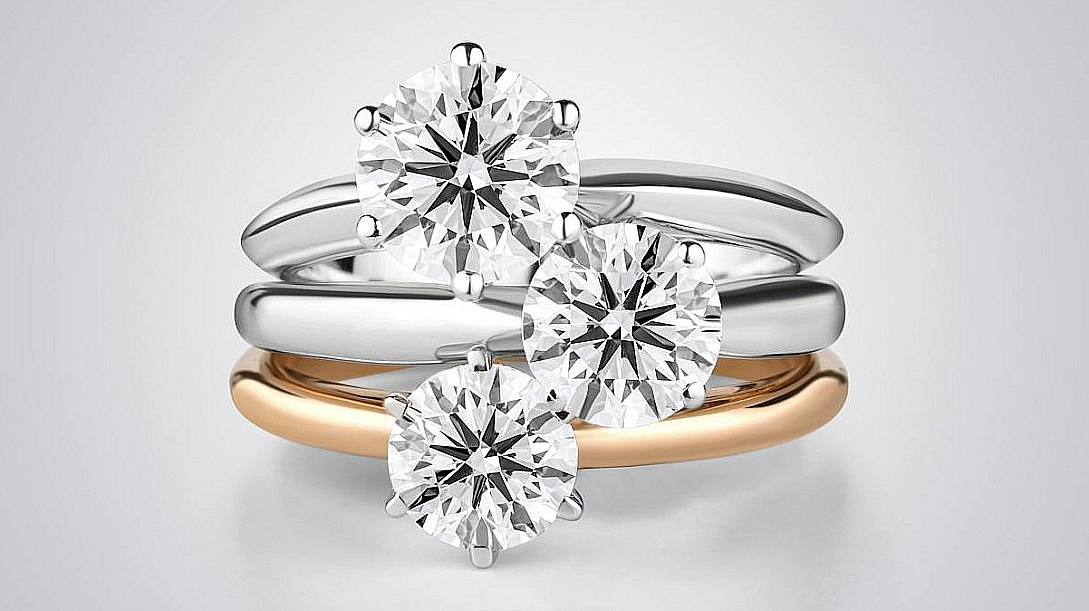
All About Gemstones and Precious Metals in Jewellery Making
Jewellery has been an integral part of human culture for millennia, symbolizing beauty, status, and personal expression. The allure of jewellery lies in its materials—gemstones and precious metals—that bring a unique blend of natural wonder and human craftsmanship. Understanding these materials is key to appreciating their value and making informed choices when creating or purchasing jewellery.
Let's delve into the fascinating world of gemstones and precious metals, exploring their properties, uses, and the artistry involved in transforming them into stunning pieces of jewellery.
Gemstones in Jewellery Making
Gemstones have captivated human imagination for centuries with their dazzling colours, intricate patterns, and remarkable durability. They are a cornerstone of jewellery design, adding colour, sparkle, and a sense of luxury to any piece.
Types of Gemstones
Gemstones are broadly categorized into two groups: precious gemstones and semi-precious gemstones. This classification, while somewhat traditional, helps in understanding the relative value and rarity of different stones.
Precious Gemstones
- Diamonds: Renowned for their unparalleled brilliance and hardness, diamonds are the most prized of all gemstones. They are primarily composed of carbon and are evaluated based on the Four Cs: Cut, Colour, Clarity, and Carat weight.
- Rubies: Known for their vibrant red hue, rubies are composed of the mineral corundum. They are highly valued for their colour, which ranges from pinkish-red to deep crimson, and their rarity.
- Sapphires: Also composed of corundum, sapphires are best known for their stunning blue shades, although they can occur in nearly every colour. The most prized sapphires are a rich, deep blue.
- Emeralds: Valued for their rich green colour, emeralds are a variety of the mineral beryl. Their vibrant colour and rarity make them highly sought after, though they are often included with natural imperfections.
Semi-Precious Gemstones
- Amethyst: This purple variety of quartz is beloved for its vibrant colour and affordability. Amethysts can range from light lavender to deep, royal purple.
- Topaz: Known for its wide range of colours, from golden yellow to blue, topaz is a versatile and popular gemstone.
- Garnet: While typically red, garnets can come in a variety of colours. They are appreciated for their durability and brilliance.
- Aquamarine: A light blue to blue-green variety of beryl, aquamarine is prized for its clarity and serene colour.
- Morganite: A delicate pink to peach variety of beryl, morganite is cherished for its romantic hues, affordability compared to diamonds, and increasing popularity in engagement rings.
- Peridot: Recognized for its distinctive lime green hue, peridot is one of the few gemstones that occurs in only one colour.
Properties of Gemstones
Understanding the intrinsic properties of gemstones is crucial for both selecting and working with them in jewellery making. Key properties include hardness, colour, clarity, carat weight, and cut.
Hardness and Durability
- Mohs Hardness Scale: This scale measures a gemstone's resistance to scratching. Diamonds top the scale at 10, making them extremely durable, while talc is at the bottom with a hardness of 1.
- Durability: Beyond hardness, durability encompasses a gemstone's toughness (resistance to breaking or chipping) and stability (resistance to chemicals, heat, and light). For example, while diamonds are exceptionally hard, emeralds, with a hardness of 7.5-8, are less tough due to their inclusions.
Colour and Clarity
- Colour: Colour is perhaps the most defining characteristic of a gemstone, influenced by its chemical composition and crystalline structure. The colour quality is assessed based on hue, tone, and saturation.
- Clarity: This refers to the presence of internal or external imperfections (inclusions and blemishes). Gemstones with fewer inclusions are generally more valuable, though some inclusions can enhance the stone's character.
Carat and Size
- Carat Weight: Carat is a measure of a gemstone's weight. One carat is equivalent to 200 milligrams. Larger stones are rarer and typically more valuable, though the overall quality also plays a significant role in determining value.
- Size: The physical dimensions of a gemstone, which can vary even among stones of the same carat weight depending on their cut and density.
Cut and Shape
- Cut Quality: The cut of a gemstone affects its brilliance and overall aesthetic. A well-cut gemstone will reflect light internally and externally to maximize its sparkle.
- Common Shapes: Gemstones can be cut into various shapes, including round, oval, princess, emerald, cushion, and pear. Each shape has unique characteristics and can influence the stone's appearance and setting in jewellery.
Popular Gemstones and Their Characteristics
Understanding the unique qualities of popular gemstones can guide you in selecting the right stone for your jewellery.
Diamonds
- Characteristics: Exceptional hardness, brilliant sparkle, and a wide range of colours (though colourless diamonds are the most prized).
- Uses: Widely used in engagement rings, earrings, necklaces, and bracelets.
Rubies
- Characteristics: Rich red colour, good hardness (9 on the Mohs scale), and rarity.
- Uses: Popular in rings, pendants, and statement pieces.
Sapphires
- Characteristics: Renowned for their deep blue colour, though they come in other colours like pink, yellow, and green. Excellent hardness (9 on the Mohs scale).
- Uses: Frequently used in rings, especially engagement rings, as well as earrings and necklaces.
Emeralds
- Characteristics: Deep green colour, often with natural inclusions. Good hardness (7.5-8 on the Mohs scale) but can be brittle.
- Uses: Favored in rings, pendants, and bracelets.
Other Popular Semi-Precious Gemstones
- Amethyst: Affordable, with a vibrant purple hue. Used in all types of jewellery.
- Topaz: Versatile, with a wide range of colours. Common in rings, pendants, and earrings.
- Garnet: Durable, with rich red tones. Often used in vintage and antique styles.
- Aquamarine: Light blue, known for clarity and calm colour. Popular in rings and necklaces.
- Peridot: Bright green, affordable. Used in a variety of jewellery pieces.
Gemstone Treatments and Enhancements
Gemstones often undergo various treatments to enhance their appearance and durability. While these treatments can improve the visual appeal of a gemstone, they also affect its value and care requirements. Understanding these treatments is crucial for making informed decisions when purchasing or working with gemstones.
Heat Treatment
- Purpose: Heat treatment is used to enhance or change the colour of gemstones. It can also improve clarity by reducing inclusions.
- Commonly Treated Gemstones: Sapphires, rubies, amethysts, and topaz are frequently heat-treated.
- Effects: Heat treatment can result in more vibrant colours and fewer visible inclusions, but it may also decrease the stone's value compared to untreated stones.
Chemical Treatment
- Purpose: Chemical treatments involve using substances to alter a gemstone's colour or clarity.
- Common Methods: Dyeing, bleaching, and diffusion.
- Commonly Treated Gemstones: Emeralds (often oiled or resin-filled to improve clarity), pearls (bleached), and some lower-quality diamonds (clarity enhanced).
- Effects: These treatments can significantly improve the gemstone's appearance but may require special care to maintain.
Irradiation
- Purpose: Irradiation uses high-energy radiation to change a gemstone's colour.
- Commonly Treated Gemstones: Topaz (to produce blue topaz), diamonds (to create fancy colours), and some types of quartz.
- Effects: The colour change is typically permanent, but irradiated gemstones may sometimes require stabilization with heat treatment.
Fracture Filling
- Purpose: Fracture filling involves injecting a substance into a gemstone's cracks to improve clarity and appearance.
- Commonly Treated Gemstones: Diamonds and emeralds.
- Effects: This treatment can enhance the visual appeal of a gemstone but may reduce its durability and require careful handling.
Surface Coating
- Purpose: Surface coating applies a thin layer to a gemstone to enhance its colour or add special effects.
- Commonly Treated Gemstones: Topaz (to create mystic topaz), quartz, and some lower-quality diamonds.
- Effects: Surface coatings can wear off over time and may need to be reapplied to maintain the gemstone's appearance.
Selecting Gemstones for Jewellery
When selecting gemstones for jewellery, it's important to evaluate their quality, consider ethical sourcing, and verify their authenticity.
Evaluating Quality
- Four Cs: Consider the Cut, Colour, Clarity, and Carat weight of the gemstone. These factors determine the stone's overall quality and value.
- Additional Factors: Look for the gemstone's origin, treatment history, and any certifications from reputable gemological laboratories.
Ethical Considerations
- Conflict-Free Sourcing: Ensure that the gemstones are sourced from regions that do not finance conflicts or exploit workers.
- Sustainable Practices: Consider gemstones from sources that adhere to environmentally sustainable practices and fair labour standards.
Certification and Authenticity
- Certified Gemstones: Purchase gemstones that come with certificates from recognized gemological laboratories (e.g., GIA, AGS) to ensure their authenticity and quality.
- Appraisals: Have your gemstones appraised by a professional to confirm their value and characteristics.
Precious Metals in Jewellery Making
Precious metals are the foundation of jewellery design, providing both structural integrity and aesthetic appeal. Their unique properties and variations play a significant role in crafting beautiful and durable jewellery pieces.
Types of Precious Metals
Gold
- Yellow Gold: The classic choice for jewellery, yellow gold is prized for its warm, rich colour. It is an alloy of gold, copper, and silver.
- White Gold: Known for its sleek, modern look, white gold is an alloy of gold and at least one white metal (usually nickel, manganese, or palladium), often plated with rhodium for enhanced whiteness.
- Rose Gold: With its romantic pink hue, rose gold is an alloy of gold and copper. The higher the copper content, the deeper the rose colour.
Silver
- Sterling Silver: Comprising 92.5% silver and 7.5% other metals (usually copper), sterling silver is durable and ideal for everyday wear.
- Fine Silver: 99.9% pure silver, fine silver is softer and more prone to damage, making it less suitable for jewellery that undergoes frequent wear.
Platinum
- Characteristics: Known for its durability and hypoallergenic properties, platinum is a dense, malleable metal with a naturally white sheen that does not tarnish.
- Uses: Often used in high-end jewellery, particularly engagement rings and wedding bands, due to its strength and ability to securely hold gemstones.
Palladium
- Characteristics: Similar to platinum, palladium is lightweight, durable, and resistant to tarnish. It is also hypoallergenic.
- Uses: Used in fine jewellery, often as an alternative to platinum due to its lower cost.
Properties of Precious Metals
Understanding the properties of precious metals helps in selecting the right material for jewellery design and ensuring its longevity.
Strength and Durability
- Gold: Pure gold (24k) is soft and malleable, making it unsuitable for everyday jewellery. Alloys like 18k and 14k gold offer greater durability while retaining gold's desirable properties.
- Silver: Sterling silver is strong enough for most jewellery applications, though it can tarnish and requires regular cleaning.
- Platinum and Palladium: Both metals are highly durable and resistant to wear, making them ideal for settings that hold valuable gemstones.
Tarnish Resistance
- Gold: Yellow and rose gold are highly resistant to tarnish. White gold, however, may require periodic re-plating with rhodium to maintain its appearance.
- Silver: Sterling silver tarnishes over time but can be easily polished. Fine silver tarnishes less but is softer and more prone to damage.
- Platinum and Palladium: Both metals are naturally tarnish-resistant, maintaining their lustre with minimal maintenance.
Weight and Density
- Gold: Gold is dense and heavy, giving it a substantial feel in jewellery.
- Silver: Lighter than gold and platinum, silver provides a comfortable and versatile option for larger pieces.
- Platinum and Palladium: Platinum is the densest and heaviest of the precious metals, while palladium is lighter, similar to gold.
Malleability and Workability
- Gold: Highly malleable, gold can be shaped into intricate designs without breaking, making it a favourite among jewellers.
- Silver: Silver's malleability allows for detailed craftsmanship, though it requires reinforcement for more delicate pieces.
- Platinum and Palladium: Both metals are malleable but require higher temperatures to work with, necessitating specialized techniques.
Alloys and Their Uses
Alloys are mixtures of metals that combine the best properties of each to enhance durability, appearance, and workability.
Gold Alloys
- 14k Gold: Contains 58.3% gold, offering a balance between durability and value. Commonly used in everyday jewellery.
- 18k Gold: Contains 75% gold, providing a richer colour and greater value but slightly less durability than 14k gold. Popular for fine jewellery.
Silver Alloys
- Sterling Silver: The standard for silver jewellery, combining strength and affordability.
- Argentium Silver: A modern alloy that includes germanium, offering enhanced tarnish resistance and durability compared to traditional sterling silver.
Platinum Alloys
- 950 Platinum: Contains 95% platinum, with the remaining 5% typically comprising metals like iridium or cobalt to enhance durability.
- 900 Platinum: Contains 90% platinum, often used in intricate designs that require a bit more flexibility.
Care and Maintenance of Precious Metals
Proper care extends the life and beauty of your precious metal jewellery.
Cleaning Techniques
- Gold: Clean with mild soap and warm water, using a soft cloth to dry and polish. Avoid harsh chemicals that can damage alloys.
- Silver: Use a silver polishing cloth or mild soap and water for regular cleaning. Store in anti-tarnish bags to minimize exposure to air.
- Platinum and Palladium: Clean with mild soap and water, and use a soft cloth to maintain their lustre. These metals require less frequent cleaning due to their tarnish resistance.
Storage Tips
- Separate Storage: Store each piece separately to avoid scratches and tangling. Use soft pouches or lined jewellery boxes.
- Humidity Control: Keep jewellery in a dry environment to prevent tarnish and corrosion, especially for silver pieces.
Avoiding Damage
- Remove Jewellery During Activities: Take off jewellery during activities that expose it to chemicals, rough handling, or potential impact, such as swimming, gardening, and exercising.
- Regular Inspections: Periodically check for loose settings, worn prongs, or other signs of damage, and have them repaired promptly by a professional.
Combining Gemstones and Precious Metals

The synergy between gemstones and precious metals is the essence of jewellery design. This combination requires a careful balance of aesthetic and practical considerations to create pieces that are not only beautiful but also durable and wearable.
Design Considerations
When designing jewellery, it's essential to consider how gemstones and precious metals will complement each other aesthetically and functionally.
Aesthetic Harmony
- Colour Coordination: Choose metal colours that enhance the gemstone's hue. For example, yellow gold pairs beautifully with warm-toned gemstones like rubies and citrines, while white metals like platinum and white gold highlight the brilliance of diamonds and sapphires.
- Design Style: Ensure that the overall design style (e.g., vintage, contemporary, minimalist) aligns with both the gemstone and metal. Delicate filigree work, for instance, suits softer-coloured gemstones and gold, while bold, modern designs often look best with stark contrasts like black onyx set in white gold.
Metal-Gemstone Compatibility
- Durability: Match the durability of the metal with the hardness of the gemstone. Softer gemstones like opals should be set in protective settings and paired with harder metals like platinum.
- Setting Type: Consider the type of setting that will best protect and showcase the gemstone. Prong settings can maximize a gemstone's sparkle, while bezel settings offer more protection for softer stones.
Practicality and Wearability
- Daily Wear: For everyday jewellery, choose durable gemstones and metals that can withstand frequent wear and tear. Diamonds, sapphires, and rubies are excellent choices for daily wear due to their hardness.
- Occasional Wear: For special occasion pieces, you can opt for more delicate gemstones and intricate designs that might not be practical for everyday use.
Crafting Techniques
Jewellery crafting techniques are essential in bringing designs to life and ensuring the longevity of the piece. These techniques include various methods of setting gemstones and working with metals.
Setting Types
- Prong Setting: Uses small metal claws to hold the gemstone in place, allowing maximum light to enter the stone from various angles. Ideal for diamonds and other hard gemstones.
- Bezel Setting: Encircles the gemstone with a thin metal rim, providing excellent protection. Suitable for softer gemstones or for a sleek, modern look.
- Pave Setting: Features small gemstones set closely together with tiny metal beads holding them in place, creating a continuous sparkle. Commonly used for accent stones.
- Channel Setting: Gemstones are set in a channel between two metal strips, offering a secure setting and a smooth surface. Often used for diamond bands.
Metalworking Methods
- Casting: The process of creating a jewellery piece by pouring molten metal into a mould. This technique allows for intricate designs and mass production.
- Soldering: Joining pieces of metal together using a filler metal (solder) with a lower melting point. Essential for creating complex designs and repairs.
- Engraving: Carving designs or inscriptions into the metal surface, adding a personal touch and intricate detail.
- Filigree: Delicate metalwork made with thin threads of metal, often twisted into intricate patterns. Common in vintage and ornate jewellery designs.
Trends in Gemstone and Metal Combinations
Jewellery trends evolve, reflecting cultural shifts and personal tastes. Understanding current trends can inspire fresh designs and ensure that your jewellery remains fashionable.
Vintage and Antique Styles
- Characteristics: Intricate details, milgrain edges, and the use of rose-cut diamonds or coloured gemstones.
- Popular Combinations: Yellow or rose gold with gemstones like emeralds, sapphires, and opals. Filigree and engraving techniques are prominent.
Contemporary and Minimalist Designs
- Characteristics: Clean lines, simple settings, and often a focus on one or two prominent gemstones.
- Popular Combinations: White gold, platinum, or palladium with diamonds or other single-colour gemstones. Bezel and tension settings are common.
Custom and Personalized Jewellery
- Characteristics: Unique designs tailored to individual preferences, often including birthstones, initials, or special symbols.
- Popular Combinations: Any combination that reflects personal significance, such as mixing different metals and a variety of gemstones. Engraving and custom settings are key features.
Jewellery-making is an art form that beautifully combines the natural allure of gemstones with the timeless elegance of precious metals. Understanding the properties and treatments of these materials, as well as the techniques used in crafting and designing jewellery, enables both jewellers and enthusiasts to create and appreciate stunning pieces that stand the test of time.
Importance of Quality and Knowledge
Choosing high-quality materials and understanding their characteristics ensures that your jewellery pieces will be both beautiful and long-lasting. Whether you are designing custom pieces or purchasing finished jewellery, this knowledge empowers you to make informed decisions and appreciate the craftsmanship involved.
The world of gemstones and precious metals is rich with history, science, and artistry. By exploring and understanding these elements, you can create and enjoy jewellery that not only adorns but also tells a story and stands as a testament to the beauty of nature and human creativity.
